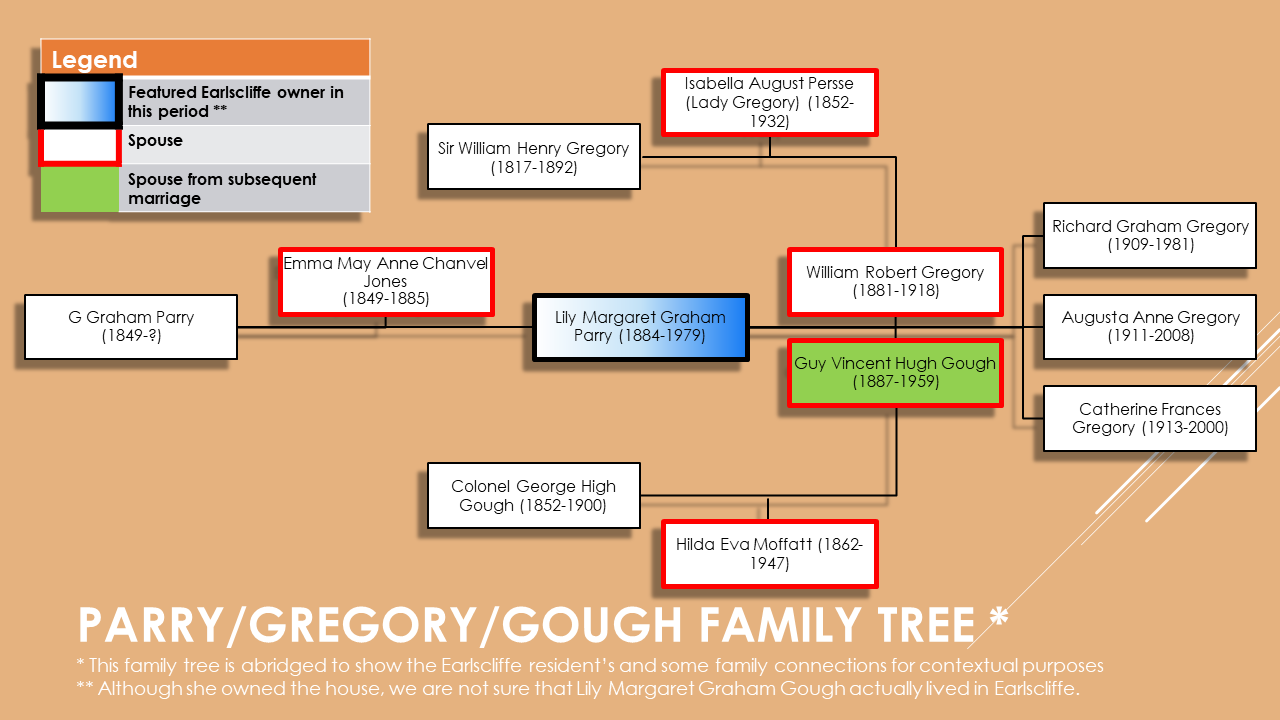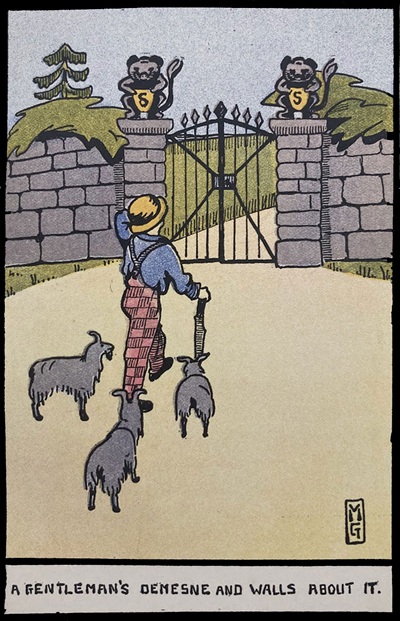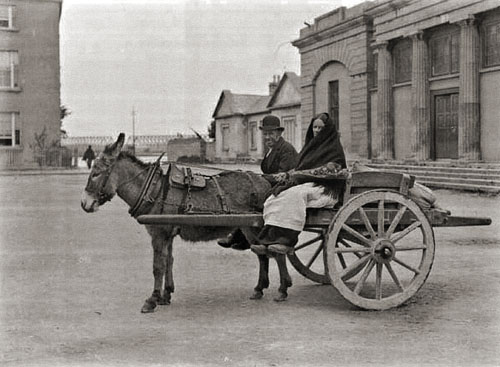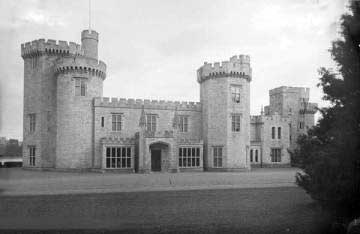History of the House / 1949 to 1950 - Lily Margaret Graham Gough
Previous / Next: 1945 to 1949 - William Martin Murphy / 1950 to 1952 - Stanley-Clarke
Earlscliffe Residents 1949 to 1950
The next person to own Earlscliffe was Lily Margaret Graham Gough.
Lily Margaret Graham Gough
Family History

Lily Margaret Graham Parry was the daughter of Graham Parry from Cheltenham, England and later of Cobham, Virginia, USA. [1]

Margaret was born on Dec 10th 1884 in Cheltenham. She studied at the Slade School of Art in London (one of her watercolours is shown on the left [16]). It was at Slade that she met Robert Gregory.
Marriage to Robert Gregory
Robert was the only son of Sir William and Lady Isabella Augusta Gregory of Coole Park, near Gort, County Galway.
Lady Augusta Gregory was a well-known dramatist and writer on Irish folklore. With William Butler Yeats and Edward Martyn, she co-founded the Irish Literary Theatre and the Abbey Theatre in Dublin. [2]
Robert's father, Sir William, who was 35 years older than Augusta, died in 1892. On his death, the house and estate at Coole were left to Robert to inherit when he reached the age of 21. However, Robert was not that interested and left the house under his mothers' care.

Robert became an accomplished artist and a renowned Irish Cricketer. [5] After meeting at the Slade School of Art, Margaret Parry and Robert married on Sept 26 1907 in Paddington, London and they had three children, Catherine, Anne, and Richard.
As a wedding gift, Lady Gregory gave Robert a house in the Burren, County Clare, called Mount Vernon.[3] Margaret and Robert used to spend their summers at Mount Vernon, often with bohemian artist friends. However, their children chose to summer at Coole with their grandmother, Lady Gregory, whom they all adored.[4]
A regular guest of Lady Gregory's at Coole was William Butler Yeats. Robert was not fond of Yeats and the way he lived when he stayed at Coole. He thought that Yeats exploited the good nature of his mother by staying in the best room in the house and drinking the best wines. Margaret agreed with Robert, resulting in regular arguments with Yeats.
The affair and the first World War
In January 1915, Robert confessed to Margaret that he was having an affair with Nora Summers, another artist he had met from Slade. Margaret was devastated, and although she did eventually meet up with Nora and her husband to discuss the affair, it didn't look like a reconciliation was on the cards.
In an attempt to end the affair, Robert decided to enlist and join the army in the first World War. At his age of 34, and with his family connections, he could have sought an easy commission, but instead chose to join the Connaught Rangers as a second lieutenant in September 1915. He then swiftly moved to the Royal Flying Corps where he showed himself to be an exceptional pilot and was awarded the Military Cross and the Legion of Honour for "many acts of conspicuous bravery". [6]
Unfortunately he was shot down and killed on January 23rd 1918 over Padua, Italy. The original story was that it was by 'friendly fire'. However, subsequently it is reported that he had had a Spanish 'Flu inoculation jab that morning and it may have caused him to black out and crash his plane. [17]
Lady Gregory received the telegram on Feb 2nd 1918 informing her of her son's death. She later wrote to Yeats:
The long dreaded telegram has come - Robert killed in action...It is very hard to bear.
She also added:
If you feel like it sometime write something down that we may keep - you understood him better than many.[13]
Yeats, who by now was married to Georgie Hyde-Lees, decided to waste no time in putting pen to paper. He eventually wrote four poems inspired by this tragic event. [7] [8]
The first, "Shepherd and Goatherd" was a long poem and, to some, seems a little pedantic. [13]
In his second poem, "In Memory of Major Robert Gregory", Yeats describes Robert's talents whilst also writing of the deaths of other friends of his.
However, his third poem, "An Irish Airman Foresees His Death" soon became one of Yeats's best known pieces of work. This sixteen line poem about an anonymous airman, shows Yeats's critical views on war in general, and on British rule over Ireland.
I know that I shall meet my fate
Somewhere among the clouds above;
Those that I fight I do not hate
Those that I guard I do not love;
My country is Kiltartan Cross,
My countrymen Kiltartan’s poor,
No likely end could bring them loss
Or leave them happier than before.
Nor law, nor duty bade me fight,
Nor public men, nor cheering crowds,
A lonely impulse of delight
Drove to this tumult in the clouds;
I balanced all, brought all to mind,
The years to come seemed waste of breath,
A waste of breath the years behind
In balance with this life, this death.
WB Yeats, 1918
Yeats did write a fourth poem in 1920, "Reprisals" about the Irish Civil war, but Lady Gregory asked him not to publish it. It was only published in 1948 after they had both died. [13]
Life at Coole in 1920s Ireland
In his will, Robert left everything he owned to his wife, Margaret, who remained on at Coole. However, Margaret's time there was not happy, and with the rise of the War of Independence in Ireland, she wondered whether the country was no longer a safe place to bring up her three children.
Ballyturin Ambush
On May 15th 1921, Margaret was the sole survivor of the Ballyturin Ambush in Gort.
On that Sunday afternoon, Margaret was travelling with Captain Blake, the District Inspector of Gort, and Mrs Blake, together with two British Military Officers from Gort. They were on their way to the residence of a local Landlord, Mr Bagott, Ballyturin House, Gort, for a game of tennis.
As they were returning to Gort that evening, they ran into an ambush by the local IRA at the entrance to Mr. Bagott’s residence, and four of the occupants of the car were killed. Margaret, the fifth, was the only one that escaped with her life. [9] [10]
The shock of seeing her friends killed in front of her was the final straw for Margaret. She decided to sell Coole to the Department of Forestry, with a proviso that Lady Gregory could live there for her lifetime. [4]
Marriage to Vincent Hugh Gough

Despite her misgivings about living in Ireland at the time, Margaret did not leave the country, and eventually married for a second time on 8th Sept 1928 to Major Guy Vincent Hugh Gough, a neighbour of hers, who lived in Lough Cutra castle in Gort, County Galway. [4]
Gough was the son of Colonel Hon. George Hugh Gough and Hilda Eve Moffatt.
In the 1920s, the Gough family had moved out of the castle as it had become too expensive to run, and relocated into converted stables on the castle grounds.
However, when Margaret married Guy Vincent Hugh Gough in 1928, they moved into Lough Cutra castle.
Purchase of Earlscliffe
Twenty years later, in March 1949, whilst now living in England but still using Lough Cutra as her Irish residential address, Margaret bought Earlscliffe at auction from William and Norah Martin Murphy for £10,100. [11]
It is not known why Margaret bought Earlscliffe. At the time she was probably living in Surrey with Major Guy Gough. Her previous home in Ireland, Lough Cutra Castle, had been vacant for a while, and Guy was in the process of selling the property. [15] Maybe Margaret saw Earlscliffe as a holiday place to visit in Ireland once the castle had been sold?
However, after purchasing Earlscliffe, the story was that Margaret never moved in, [12] and instead put it straight up for sale later in September 1949.
The house didn't sell until May 1950, when it was bought by Brigadier Arthur Christopher Lancelot ("Kit") Stanley-Clarke for his wife Olive.[12]
Lough Cutra castle was subsequently purchased in late 1952 by Michael Russell from Scotland. [14]
Margaret and Guy continued to live in England. Sadly, Guy, died on March 26th, 1959. Margaret lived for another 20 years, dying in Exeter, Devonshire, England on November 27, 1979, aged 94. [4]
Further information
• •
List of Earlscliffe Residents
References
- [1] The Peerage website http://www.thepeerage.com/p47307.htm
- [2] As an aside, Mahaffy was a supporter of Lady Gregory's work. In Stanford and McDowell's book on Mahaffy, they mention that he sent a subscription to the Irish National Theatre, with a personal note to Lady Gregory. John Pentland Mahaffy: Biography of an Anglo-Irishman, W B Stanford and R B McDowell, Publisher: Routledge & Kegan Paul Ltd, 1971, ISBN 0 7100 6880 8
- [3] History of Mount Vernon Guest House, Co Clare, Ireland, accessed 31st August 2018
- [4] Mrs Margaret Gregory, accessed 31st August 2018 and "The Lady who sold Coole Park, by Ronnie O'Gorman, Galway Advertiser, Oct 25, 2012 https://www.advertiser.ie/galway/article/56079/the-lady-who-sold-coole-park accessed 20th March 2023.
- [5] ESPN cricinfo, accessed 31st August 2018
- [6] "Harrow memorials of the great war : August 23rd, 1914, to March 20th, 1915" as seen at http://www.archive.org/stream/harrowmemorialso05warn/harrowmemorialso05warn_djvu.txt , accessed 31st August 2018
- [7] "Representing the Great War: Texts and Contexts", The Norton Anthology of English Literature, 8th edition, accessed 31st August 2018.
- [8] Obituary "Robert Gregory (1881-1918): "Soldier, Scholar, Horseman", accessed 31st August 2018
- [9] "Ballyturin (or Ballyturin) Ambush, Gort, Galway", accessed 3th October 2021
- [10] "Abandoned Ireland, Ballyturin House, County Galway", accessed 31st August 2018
- [11] Irish Times, March 16 1949 pg 4, plus copy of deeds currently in the possession of Karen Foley
- [12] As told by Olive Stanley Clarke to David Robinson in the 1980s.
- [13] An Irish Airman by Ronnie O'Gorman Feb 15th 2018 https://www.advertiser.ie/galway/article/98640/an-irish-airman accessed 20th March 2023 and Yeats’s ‘perfect man’ by James Pethica https://thedublinreview.com/article/yeatss-perfect-man/ accessed 20th March 2023
- [14] The Chequered History of Lough Cutra, Connacht Tribune 15th November 1952 page 5.
- [15] Future of Gort ancestral home, Irish Times, 5th November 1952 page 3.
- [16] In 1910, Margaret did a series of illustrations for Lady Gregory's book "The Kiltartan Wonder Book". In Judith Hill's biography, "Lady Gregory: An Irish Life", they were described as 'very charming' by Lady Gregory.
- [17] As reported in "Challenge to official accounts of Gregory death in WWI", by Ray Burke, 6 Jan 2018. https://www.rte.ie/news/analysis-and-comment/2018/0102/930446-robert-gregory/ accessed 30th March 2023.
This page was last updated on 27-Jul-2023 .
